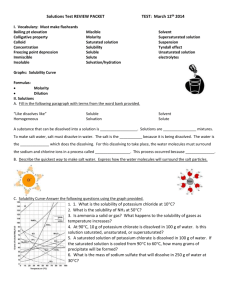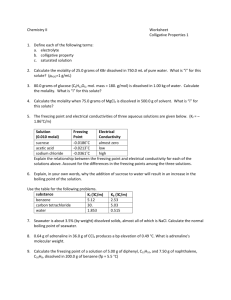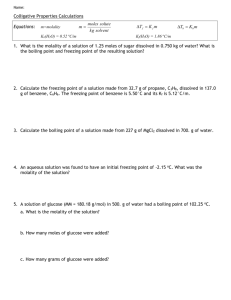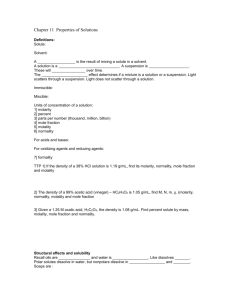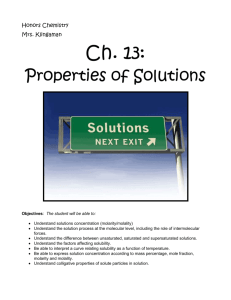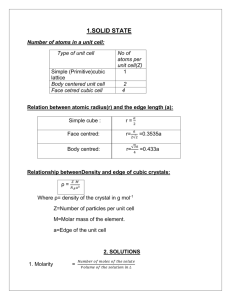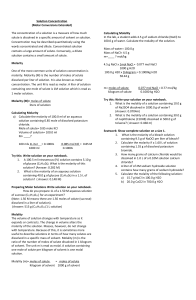exercise - Baroda High School
advertisement
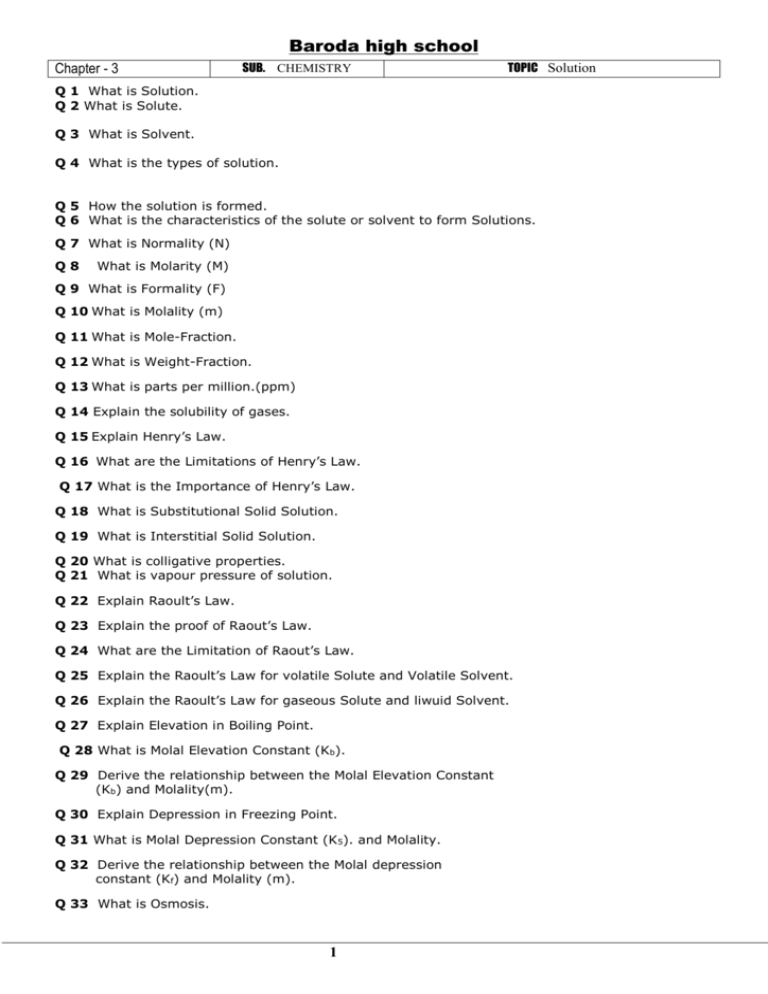
Baroda high school Chapter - 3 SUB. CHEMISTRY TOPIC Solution Q 1 What is Solution. Q 2 What is Solute. Q 3 What is Solvent. Q 4 What is the types of solution. Q 5 How the solution is formed. Q 6 What is the characteristics of the solute or solvent to form Solutions. Q 7 What is Normality (N) Q8 What is Molarity (M) Q 9 What is Formality (F) Q 10 What is Molality (m) Q 11 What is Mole-Fraction. Q 12 What is Weight-Fraction. Q 13 What is parts per million.(ppm) Q 14 Explain the solubility of gases. Q 15 Explain Henry’s Law. Q 16 What are the Limitations of Henry’s Law. Q 17 What is the Importance of Henry’s Law. Q 18 What is Substitutional Solid Solution. Q 19 What is Interstitial Solid Solution. Q 20 What is colligative properties. Q 21 What is vapour pressure of solution. Q 22 Explain Raoult’s Law. Q 23 Explain the proof of Raout’s Law. Q 24 What are the Limitation of Raout’s Law. Q 25 Explain the Raoult’s Law for volatile Solute and Volatile Solvent. Q 26 Explain the Raoult’s Law for gaseous Solute and liwuid Solvent. Q 27 Explain Elevation in Boiling Point. Q 28 What is Molal Elevation Constant (Kb). Q 29 Derive the relationship between the Molal Elevation Constant (Kb) and Molality(m). Q 30 Explain Depression in Freezing Point. Q 31 What is Molal Depression Constant (K5). and Molality. Q 32 Derive the relationship between the Molal depression constant (Kf) and Molality (m). Q 33 What is Osmosis. 1 Baroda high school Chapter - 3 SUB. CHEMISTRY TOPIC Solution Q 34 What is Osmotic Pressure (). Q 35 Explain Boyle – Van’t Hoff Law. Q 36 Explain Charles – Van’t Hoff Law. Q 37 Explain Avogodro – Van’t Hoff Law. Q 38 What is Isotonic Solutions. Q 39 Explain method to determine the molecular weight of solute by using Raoult’s Law. Q 40 Explain method to determine the molecular weight of solute by using Molal elevation measurement method. Q 41 Explain method to determine the molecular weight of solute by using Molal depression measurement method. Q 42 Explain method to determine the molecular weight of solute by using Osmotic pressure measurement method. . Q 43 What is Dissolution. Q 44 What is Association. Q 45 Explain Van’t – Hoff factor (i). Exercise : 1 1. If 11 g oxalic acid are dissolved in 500 mL of solution (density = 1.1 g mL -1), what is the mass % of oxalic acid in solution ? 2. 2.46 g of sodium hydroxide (molar mass = 40) are dissolved in water and the soluton is made to 100 cm3 in a volumetric flask. Calculate the molarity of the solution. 3. Calculate the molarity of a solution containing 20.7 g of potassium cabronate dissolved in 500 mL of solution (assume density of solution = 1 g mL-1). 4. A solution is prepared by adding 60 g of methyl alcohol to 120 g of water. Calculate the mole fraction of methanol and water. 5. Calculate the normality of solution containing 31.5 g of hydrogen oxalic acid (H2C2O4. 2H2O) in 1250 mL of solution. 6. 2.82 g of glucose (molar mass = 180) are dissolved in 30g of water. Calculate (a) the molality (b) mole fraction of glucose and water. 7. Calculate the molarity of pure water (density of water = 1 g mL-1). 8. Calculate the moles of methanol in 5 litres of its 2 m solution, if the density of the solution is 0.981 kg L-1 (Molar mass of methanol = 32.0 g mol -1). 9. A solution glucose in water is labelled as 10% (w/w). The density of the solution is 1.20 g mL-1. Calculate (i) molality (ii) molarity, and (iii) mole fraction of each component in solution. 10. A commercilly available sample of sulphuric acid is 15% H 2SO4 by weight (density = 1.10 mL-1). Calculate (i) molarity (ii) normality and (iii) molality of the solution. 2 Baroda high school Chapter - 3 SUB. CHEMISTRY TOPIC Solution 11. Benzene and toluene form nearly ideal solution. At a certain temperature, the vapour pressure of the pure benzene is 150 torr and of pure toluene is 50 torr. Calcualte the vapour pressure of the solution containing equal weights of two substances at this temperature. 12. At 298 K, the vapour pressure of water is 23.75 mm Hg. Calculate the vapour pressure at the same temperature over 5% aqueous solution of urea (NH 2CONH2). 13. The boiling point of pure water is 100 C. Calculate the boiling point of an aqueous solution containing 0.6 g of urea (molar mass = 60) in 100 g of water. (K b for water = 0.52 K/m). 14. Molal elevation constant for benzene is 2.52 K/m. A solution of some organic substance in benzene boils at 0.126 C higher than benzene. What is the molality of the solution ? 15. 45 g ethylene glycol (C2H6O2) is mixed with 600 g of water. Calculate (i) the freezing point depression (ii) the freezing point of the solution. (Kf for water = 1.86 K kg mol-1) 16. Addition of 0.643 g of a compound to 50 mL of benzene (density 0.879 g / ml) lowers the freezing point from 5.51C. If Kf for benzene is 5.12 K kg mol -1, calcualte the molar mass of the compound. 17. 200 cm3 of an aqueous solution of a protein contains 1.26 g of the protein. The osmotic pressure of such a solution at 300 K is found to be 2.57 10-3 bar. Calculate the molar mass of the protein. (R = 0.083 L bar mol-1 K-1). 18. If 1.71 g of sugar (molar mass = 342) are dissolved in 500 cm3 of a solution at 300 K, what will be its osmotic pressure ? (R = 0.083 L bar K -1 mol-1). 19. A solution containing 0.5 g KCl dissolved in 100 g of water freezes at -0.24 C. Calculate the degree of dissociation of the salt (Kf for water = 1.86 C). 20. A solution containing 3.100 g of BaCl 2 in 250 g of water boils at 100.083 C. Calculate the ratio of Van’t Hoff factor and molality of BaCl 2 in this solution. (Kb for water = 0.52 Km-1, molar mass of BaCl2 = 208.3 g mol-1) Text Book Questions 1. How many grams of H2SO4 is required to prepare 5 litres of 2 NH2SO4? 2. Find the normality and molarity of solution formed when 9.8 gram of H2SO4 is dissolved in 500 ml of water.. 3. Find the value of formality and molarity when 20 gram of potassium alum (K 2SO4 Al2 (SO4)3 24H2O) are dissolved in 2 litres of solution. 4. How many grams of NaOH are required to prepare 200 gram of 2 molal NaOH solution? 5. Find the molality and mole fraction of 10% w/v NaOH solution. 6. Find normality and molarity of 10% w/v NaOH solution. 7. Find the Henry’s law constant when O2 millimoles become soluble. The partial pressure of O 2 gas is 2 10-8.The vapour pressure of a solution prepared by dissolving 36 gram of glucose in 1800 gram of water at 27 C, is 24.4 mm. Calculate the vapour pressure of pure solvent at this temperature. 8. The solution prepared by dissolving 3.42 gram sugar in 200 gram of water at 25 C shows elevation in boiling point as 0.22. Calculate the molal elevation constant. 9. Find the melting point of a solution obtained by dissolving 11.7 gram NaCl in 500 gram ice. Kf of the solution is 4.5 K kgmole-1. 3 Baroda high school Chapter - 3 SUB. CHEMISTRY TOPIC Solution 10. Find the osmic pressure at 27 C of a glucose solution with concentration equal to 3.6 % w/v.. 11. If the vapour pressure of 2 gram of unknown substance dissolved in 90 gram water at 25 C decreses from 27.5 mm to 27.1 mm. Find the molecular weigtht of unknown substance. 12. The boiling point of a solution obtained by dissolving 5 gram of unknown substance in one kilogram of water increases by 0.8 C kg.mole-1 for solvent. 13. The melting point of a solution of 4.5 gram unknown substance in 1500 gram water shows decrease of 0.50 C. calculate the molecular weight of unknown substance. (K f = 4.2 K kgmole1 ). 14. At 27 C, 7.5 gram of unknown substance dissolved in water and Made the volume of soluti9on equal to 10 litre, shows osmotic pressure of 0.25 atm. Calculate the molecular weight of unknown substance. (73.8 gm/mole). 4
